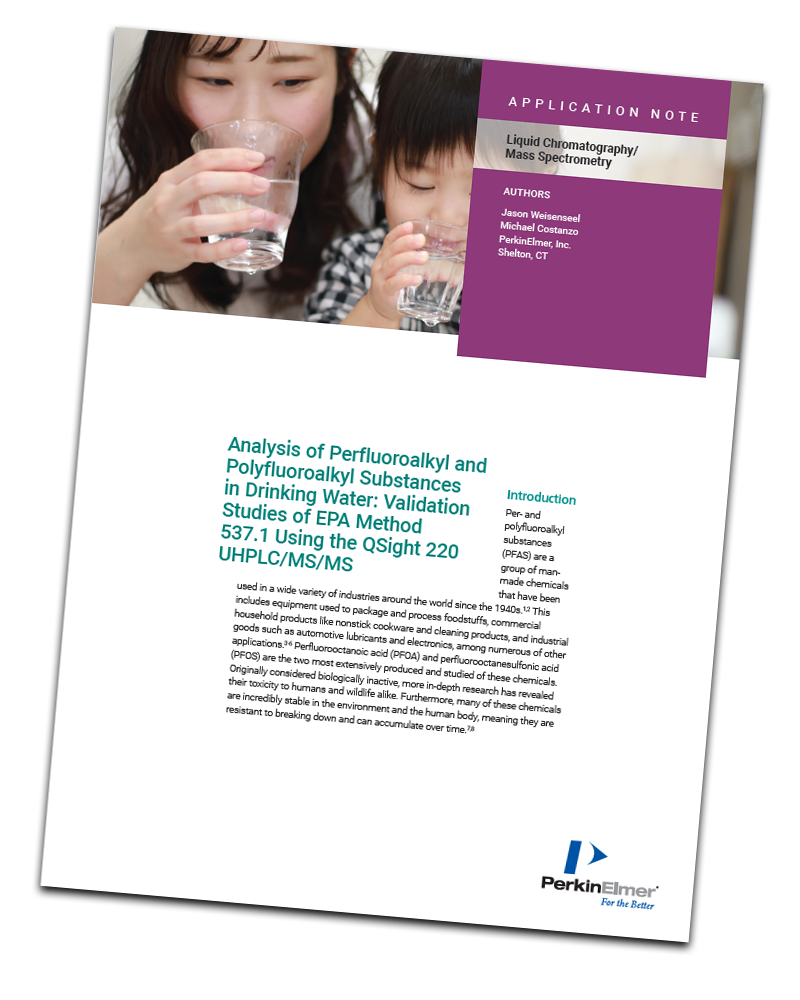This application note focuses on the validation of EPA Method 537.1, as well as the development of an improved version of this methodology.
 Per- and polyfluoroalkyl substances (PFAS) are a group of man-made chemicals that have been used in a wide variety of industries around the world since the 1940s. This includes equipment used to package and process foodstuffs, commercial household products like nonstick cookware and cleaning products, and industrial goods such as automotive lubricants and electronics, among numerous of other applications. Perfluorooctanoic acid (PFOA) and perfluorooctanesulfonic acid (PFOS) are the two most extensively produced and studied of these chemicals. Originally considered biologically inactive, more in-depth research has revealed their toxicity to humans and wildlife alike. Furthermore, many of these chemicals are incredibly stable in the environment and the human body, meaning they are resistant to breaking down and can accumulate over time.
Per- and polyfluoroalkyl substances (PFAS) are a group of man-made chemicals that have been used in a wide variety of industries around the world since the 1940s. This includes equipment used to package and process foodstuffs, commercial household products like nonstick cookware and cleaning products, and industrial goods such as automotive lubricants and electronics, among numerous of other applications. Perfluorooctanoic acid (PFOA) and perfluorooctanesulfonic acid (PFOS) are the two most extensively produced and studied of these chemicals. Originally considered biologically inactive, more in-depth research has revealed their toxicity to humans and wildlife alike. Furthermore, many of these chemicals are incredibly stable in the environment and the human body, meaning they are resistant to breaking down and can accumulate over time.
Growing health concerns regarding PFAS and their prevalence in consumer goods and the environment indicates a critical need to simply and reliably execute existing and upcoming regulatory methods on commercially available instrumentation. The United States Environmental Protection Agency (EPA) recently updated their Method 537.1, which is the current standard method for analysis of PFAS in drinking water. EPA Method 537.1 is utilized for the determination of selected PFAS in drinking water by solid phase extraction (SPE) and liquid chromatography/mass spectrometry (LC/MS/MS). Other published methods, including EPA Method 533 and provisional EPA Method 8327, may be utilized for analysis of PFAS in more diverse matrices and sample types.
This application note uses the PerkinElmer QSight® LX50 ultra high-performance liquid chromatography (UHPLC) system coupled with the PerkinElmer QSight 220 triple quadrupole mass spectrometer. The results demonstrate that all the PFAS analytes listed in EPA Method 537.1 can be determined reliably by the QSight 220 LC/MS/MS system, with good recovery and precision at low limits of quantification (LOQs).
The validation studies demonstrate that excellent linearity was achieved for all PFAS analytes and surrogates, with the R2 values ≥0.996. The instrument LODs and LOQs verify that the QSight 220 has ample sensitivity required to quantify the PFAS analytes listed in US EPA Method 537.1.
In conclusion, municipal drinking water samples from three sampling sites were quantified with validated recoveries and repeatability within the method requirements. Surrogate standard recoveries in field samples validated the effectiveness of the sample preparation method. Overall, this validation study shows that the LX50 UHPLC system coupled to the QSight 220 tandem quadrupole mass spectrometer (LC/MS/MS) is an excellent system for the application of EPA Method 537.1 with ample sensitivity to measure all analytes.
